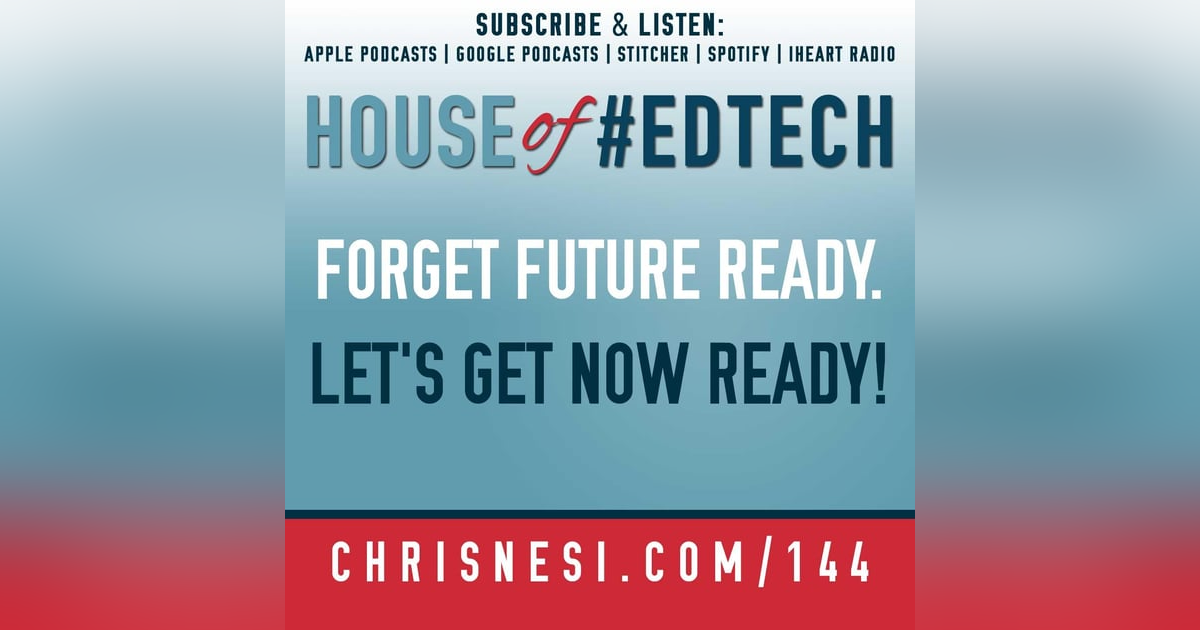Forget #FutureReady. Let's Get NOW Ready! - HoET144

Yes, I said it. It's time to forget Future Ready.
Feedback, Shoutouts, and Links
- “Enjoyed the #houseofedtech podcast with @mrnesi featuring @MandiTolenEDU discussing digital escape rooms this morning on my car PD ride in” – Jessica James @MrsJamesACPS
- Derek Larson got value from episode 140’s #edtech recommendation about email management.
- A reminder that I am currently accepting submissions for the 2019 HOET Smackdown! The 6th Annual Smackdown will be the last episode for 2019. Get your edtech recommendations, tips, and more to me by December 1st, 2019. Choose the best way for you to share by visiting chrisnesi.com/feedback
#EdTech Recommendation
- Kristi Adams – via the FB Group
- HS Librarian I have several collaborative student podcasting projects that I’m planning, & I would like to introduce the students to some exceptional examples of a podcaster’s use of tone, vocal inflection & personality. (Preferably age-appropriate & engaging for teens) I’d greatly appreciate your suggestions!
- This American Life, Short Wave, ThroughLine
- But I also recommend showing students how to use a podcast app on their phone (Overcast, Apple Podcasts, Pocket Casts, Google Podcasts) and search for something they're interested in – Sports, Fashion, Entertainment, etc. and encourage them to find what they like and develop their podcast listening tastes. This will certainly help them find their voice when asked to create their own podcasts.
Featured Content
Forget Future Ready…Let’s get NOW ready.
Yes, I said it. It’s time to forget Future Ready. Back in 2015 on episode 28, I spoke with Tom Murray all about Future Ready. Here we are 4 years later and my first-hand experience is that Future Ready is a gimmick. Initially, I was excited at the prospect of Superintendents taking a pledge to transform schools and empower educators and really re-think learning and instruction in a way that wasn’t driven by technology but leveraged technology. But prior to 2015 school superintendents weren’t already pledging to transform schools and empower their teaching staff? Superintendents weren’t committed to excellence before 2015?
Here in NJ, FutureReady is the equivalent of a badge in your email and districts are just looking for meaningless feathers in their caps. I mean up until recently the face of FR in NJ never spent time in a classroom as a teacher and has never worked in a school. I say up until recently because the State DOE recently took over the program.
People forget that Education is an institution. Institutions are these ideas that have always existed and will continue to exist. Institutions influence and manage how we live our lives from day to day and impact the decisions we make and how we act. But, institutions change over time. Government, Family, Medicine, Economics, Education. These have always existed by they have changed and evolved over long and short periods of time. Education, today, in some ways does resemble education 60 years ago, while overall it looks nothing like it did 600 years ago. I graduated hs 20 years ago and hs today isn’t worth comparing it to. There are some days I think I would have thrived if I was a student today and other days I don’t know how I would have managed.
If you’re a teacher then I think you have some power to shape your content in a meaningful way that will add value to your students’ experience. For example, my world history class isn’t about history. I’m not hell-bent on getting kids to memorize names and dates and historical facts. I’m preparing them to play Jeopardy or Trivial Pursuit. I’m using history to teach them skills and to be able to DO.
Whatever the components of the future are I can say with conviction that it’s not about how much your district shares on Twitter or posting drone flyover shots of your school. It’s not about removing books from libraries and turning academic areas into little coffee houses. It’s not about how many representatives you can send to yet another institute or summit. It’s not about just talking about what you’d like to see happen.
Just Give It A Try
Kelley Schemmel shared her story about recently using digital breakouts in her classroom and she shared the following tools:
- https://www.abcya.com/games/decoder_puzzle
- https://crosswordlabs.com/
- https://www.jigsawplanet.com/
- https://deck.toys/
- https://flippity.net/
House of #EdTech VIP
Trevor Bryan – NJ Art Teacher and Co-creator of the 4OCF blog and community. Author of The Art of Comprehension. Helping Students Confidently Explore Comprehension Skills & Writer’s craft through Visual Texts
In The Art of Comprehension, Trevor introduces his signature method for enhancing students’ understanding and thinking about all texts—both written and visual. By using what he calls “access lenses” (such as faces, body language, sound/silence) you can prompt all your students to become active explorers and meaning-makers. Organically and spontaneously, your classroom will become more student-centered. Cover and illustrations by Peter H. Reynolds.
Connect with Trevor Bryan:
- Twitter: @trevorabryan
ASK QUESTIONS, SHARE YOUR FEEDBACK, AND CONNECT WITH ME
- Comment on the show notes below
- Click here to leave a voicemail
- Subscribe & Follow the House of #EdTech
- Email feedback@chrisnesi.com (audio files welcome)
THANK YOU TO MY AWESOME SUPPORTERS!
CLICK HERE TO BECOME AWESOME!
- Leo Calbusch - @leocalbusch
- Bryon Carpenter - bryoncarpenter.com
- Erin Cummings - @ErinC_CCIU
- Jeff Herb - instructionaltechtalk.com
- Matt Miller - Ditch That Textbook
CHECK OUT MORE EDUCATION PODCAST NETWORK SHOWS
SUPPORT THESE BRANDS AND COMPANIES AND YOU WILL BE SUPPORTING THE PODCAST.
DISCLOSURE
This post may contain links to products or services with which I have an affiliate relationship. I may receive commissions or bonuses from your actions on such links.
















